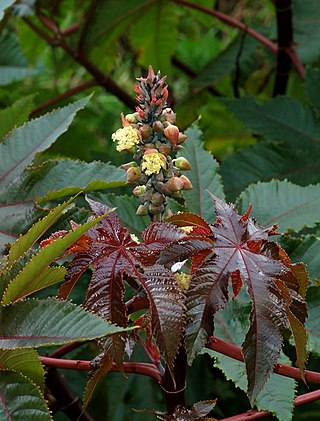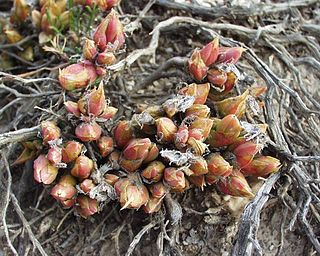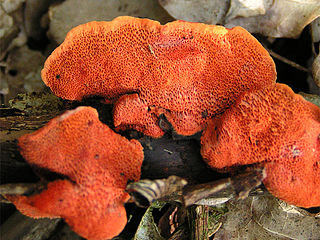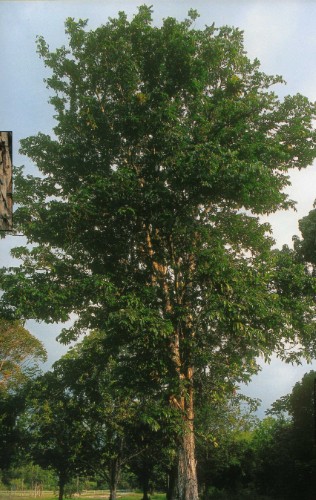
Ribavirin, also known as tribavirin, is an antiviral medication used to treat RSV infection, hepatitis C and some viral hemorrhagic fevers. For hepatitis C, it is used in combination with other medications such as simeprevir, sofosbuvir, peginterferon alfa-2b or peginterferon alfa-2a. Among the viral hemorrhagic fevers it is used for Lassa fever, Crimean–Congo hemorrhagic fever, and Hantavirus infection but should not be used for Ebola or Marburg infections. Ribavirin is taken by mouth or inhaled.

Ricinus communis, the castor bean or castor oil plant, is a species of perennial flowering plant in the spurge family, Euphorbiaceae. It is the sole species in the monotypic genus, Ricinus, and subtribe, Ricininae. The evolution of castor and its relation to other species are currently being studied using modern genetic tools. It reproduces with a mixed pollination system which favors selfing by geitonogamy but at the same time can be an out-crosser by anemophily or entomophily.

Mycoremediation is a form of bioremediation in which fungi-based remediation methods are used to decontaminate the environment. Fungi have been proven to be a cheap, effective and environmentally sound way for removing a wide array of contaminants from damaged environments or wastewater. These contaminants include heavy metals, organic pollutants, textile dyes, leather tanning chemicals and wastewater, petroleum fuels, polycyclic aromatic hydrocarbons, pharmaceuticals and personal care products, pesticides and herbicides in land, fresh water, and marine environments.
The name Catuaba is used for the infusions of the bark of a number of trees native to Brazil. The most widely used barks are derived from the trees Trichilia catigua and Erythroxylum vaccinifolium. Other catuaba preparations use the bark of trees from the following genera or families: Anemopaegma, Ilex, Micropholis, Phyllanthus, Secondatia, Tetragastris and species from the Myrtaceae.

Mesembryanthemum tortuosum is a succulent plant in the family Aizoaceae native to the Cape Provinces of South Africa. It is known as kanna, channa, kougoed —which literally means, 'chew(able) things' or 'something to chew'.

Ganoderma applanatum is a bracket fungus with a cosmopolitan distribution.

A wood-decay or xylophagous fungus is any species of fungus that digests moist wood, causing it to rot. Some species of wood-decay fungi attack dead wood, such as brown rot, and some, such as Armillaria, are parasitic and colonize living trees. Excessive moisture above the fibre saturation point in wood is required for fungal colonization and proliferation. In nature, this process causes the breakdown of complex molecules and leads to the return of nutrients to the soil. Wood-decay fungi consume wood in various ways; for example, some attack the carbohydrates in wood, and some others decay lignin. The rate of decay of wooden materials in various climates can be estimated by empirical models.

Pycnoporus is a genus of fungi in the family Polyporaceae. This genus is distinguished from most other polypores because of its brilliant red-orange color. Modern mycology recognizes five distinct species of Pycnoporus: the type P. cinnabarinus, P. coccineus, P. palibini, P. puniceus, and P. sanguineus. These species are divided somewhat by morphology, biogeography, and DNA sequence.

Artemisia herba-alba, the white wormwood, is a perennial shrub in the genus Artemisia that grows commonly on the dry steppes of the Mediterranean regions in Northern Africa, Western Asia and Southwestern Europe. It is used as an antiseptic and antispasmodic in herbal medicine.

Traditional African medicine is a range of traditional medicine disciplines involving indigenous herbalism and African spirituality, typically including diviners, midwives, and herbalists. Practitioners of traditional African medicine claim, largely without evidence, to be able to cure a variety of diverse conditions including cancer, psychiatric disorders, high blood pressure, cholera, most venereal diseases, epilepsy, asthma, eczema, fever, anxiety, depression, benign prostatic hyperplasia, urinary tract infections, gout, and healing of wounds and burns and even Ebola.

Croton lechleri is a species of flowering plant in the spurge family, Euphorbiaceae, that is native to northwestern South America. It is commonly known as sangre de grado, sangre de drago or sangre de grada. They refer to this tree's thick red latex.

Bakuchiol is a meroterpene in the class terpenophenol.

Amanita augusta is a small tannish-brown mushroom with cap colors bright yellow to dark brown and various combinations of the two colors. The mushroom is often recognizable by the fragmented yellow remnants of the universal veil. This mushroom grows year-round in the Pacific Northwest but fruiting tends to occur in late fall to mid-winter. The fungus grows in an ectomycorrhizal relationship with hardwoods and conifers often in mixed woodlands.

Norbadione A is a pigment found in the bay bolete mushroom. A polyphenol, norbadione A is related to a family of mushroom pigments known as pulvinic acids. The molecule has also been reported as a potassium salt from the mushrooms Pisolithus tinctorius and Chalciporus piperatus.

Pycnoporus coccineus is a saprophytic, white-rot decomposer fungus in the family Polyporaceae. A widely distributed species, the fungus was first described scientifically by Elias Magnus Fries in 1851. A study conducted by Couturier al et. (2015) concluded that the combined analysis of sugar and solid residues showed the suitability of P. coccineus secreted enzymes for softwood degradation. P. coccineus is a promising model to better understand the challenges of softwood biomass deconstruction and its use in biorefinery processes.

Carapa guianensis is a species of tree in the family Meliaceae, also known by the common names andiroba or crabwood.
Trichoderma longibrachiatum is a fungus in the genus Trichoderma. In addition to being a distinct species, T. longibrachiatum also typifies one of several clades within Trichoderma which comprises 21 different species. Trichoderma longibrachiatum is a soil fungus which is found all over the world but mainly in warmer climates. Many species from this clade have been adopted in various industries because of their ability to secrete large amounts of protein and metabolites.

Spooky toxin (SsTx) is a small peptide neurotoxin. It is found in the venom of Chinese red-headed centipedes, also known as golden head centipedes. It is originally composed of 76 amino acids, with a molecular weight of 6017.5 Daltons, but loses the first 23 residues and becomes 53 residues long. SsTx is currently thought to be unique to Scolopendra subspinipes mutilans.
Mycorrhizal amelioration of heavy metals or pollutants is a process by which mycorrhizal fungi in a mutualistic relationship with plants can sequester toxic compounds from the environment, as a form of bioremediation.

Ben-Erik van Wyk FAAS is a South African professor of indigenous botany and traditional African medicine at the University of Johannesburg.

















